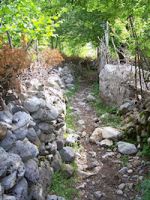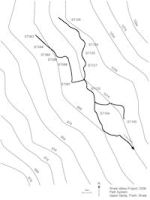


Figure 28: Shteg, Theth Kolaj (Galaty).
Figure 29: The path (shteg) network in Theth Kolaj/Theth Ulaj, with Beta index of 1.125 (Galaty).
Figure 30: The path (shteg) network in Theth Gjelaj, with Beta index of 0.92 (Galaty).
To confirm further our sense of the relative age of the various neighbourhoods within Theth we analysed the system of paths. Paths (shtegu) of various kinds wind throughout Theth, connecting households and neighbourhoods, and providing access to various natural resources. Different kinds of paths are found in different neighbourhoods. A true shteg is usually sunk a metre, or more, into the ground and lined on either side with stones (Fig. 28). Locals say that a good shteg allows a man to move from place to place on the landscape without exposing himself to hostile fire. Gjeçaj, which we assume to be one of the younger neighbourhoods, has only one true shteg, which runs from one end of the neighbourhood to the other. Rrogam, mentioned above, has no true shtegs that we could find; perhaps they were unnecessary because blood feuds did not occur during Communism, or it may be that not enough time had passed for deeply incised paths to form or be built. Older neighbourhoods, on the other hand, incorporate intricate networks of paths. We mapped paths in two of Theth's neighbourhoods, Upper Gjelaj and Kolaj-Ulaj (Figs. 29 and 30).



On first inspection, the paths in Gjelaj and Kolaj-Ulaj are superficially similar, but the system in Kolaj-Ulaj is somewhat more complex. In order to compare the path systems, we used a simple form of linear network analysis based on graph theory (Haggett 1966). The path system in Upper Gjelaj is composed of thirteen vertices and twelve edges. Its Beta index, or degree of connectivity, is 0.92. The Gjelaj path system can be described as a 'tree' graph (i.e., branching, containing no circuits). Trees typically indicate low connectivity and minimal system complexity. The total length of the Gjelaj path system is 652m and its diameter is 456m. Kolaj-Ulaj is composed of seventeen vertices and sixteen edges and its Beta index is 0.94, also a tree. The length of the system is 1388m, its diameter is 1046m. When Kolaj-Ulaj is split into its two constituent neighbourhoods, Kolaj and Ulaj (which adds an additional boundary vertex and edge), the Beta index for Ulaj changes to 1.125 (Kolaj's Beta is 0.9). This indicates the Ulaj system's greater degree of connectivity and circular shape. A graph analysis of the Gjeçaj shteg, which runs in a straight line between the upper and lower portions of the neighbourhood past several houses, produces a Beta index well below 1.0 and is the least complex graph of the four.
We attribute the differences in the four path systems to chronological variation. Ulaj may be the oldest of the neighbourhoods, followed by Kolaj and Upper Gjelaj, and lastly Gjeçaj. These results fit well the results of the 2005 architectural survey, which found the greatest degree of architectural complexity in Ulaj. Ulaj also possesses very complex terrace and irrigation systems.
© Internet Archaeology/Author(s)
URL: http://intarch.ac.uk/journal/issue27/1/5.3.1.4.cfm
Last updated: Thu Feb 25 2010